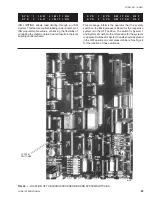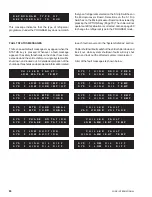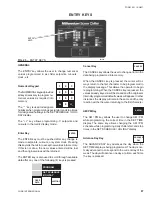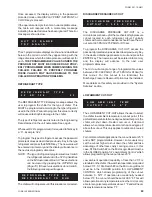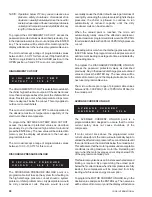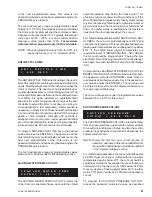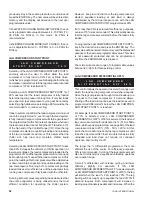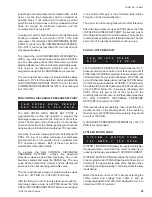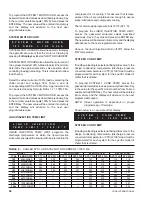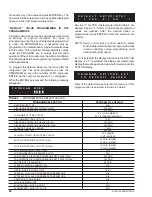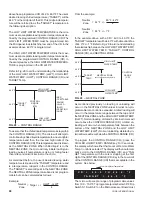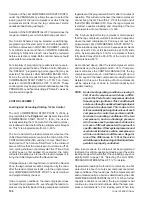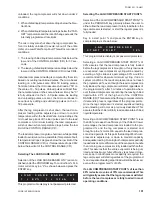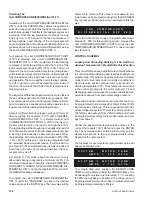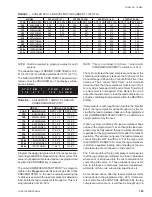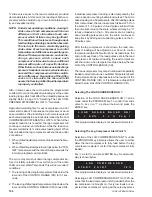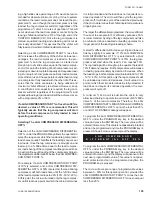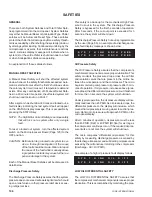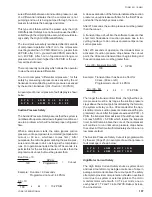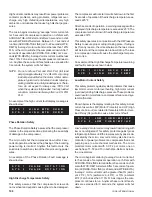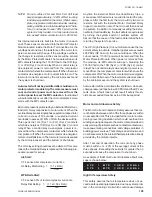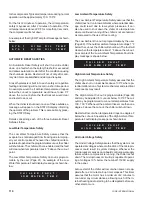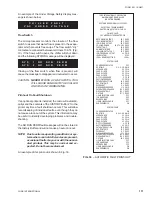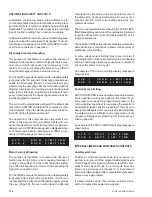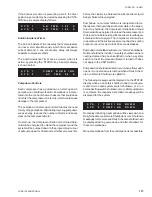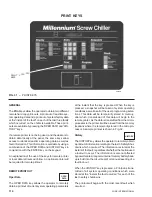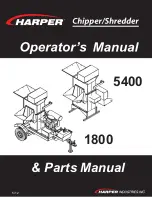
FORM 201.10-NM1
99
YORK INTERNATIONAL
be properly programmed for Brine Cooling (see page 80).
If the switch is incorrectly selected, when setpoints be-
low 38°F are entered, as well as when unacceptable val-
ues are entered, the following message will be displayed:
After the LOW LIMIT WATER TEMP. (LLWT) is keyed in,
the cursor will automatically advance to the final entry
which is the upper limit (HIGH LIMIT WATER TEMP.) of
the CONTROL RANGE (CR). This value should be pro-
grammed for the highest leaving water temperature which
is acceptable in the system application. Typically 4°F
above the LLWT is acceptable. The micro will accept a
value 1 - 5°F above the LLWT. 4°F above the LLWT is the
default value.
Key in the upper limit HIGH LIMIT WATER TEMP (HLWT)
of the CR and press the ENTER key. After pressing the
ENTER key, the display will continue to show the mes-
sage until another key is pressed. See below:
High Limit Water Temperature
This display will automatically show the “TARGET” tem-
perature which is the desired leaving chilled liquid tem-
perature and the actual chilled liquid temperature the micro
will attempt to control to. The “TARGET” temperature will
always be the midpoint of the CONTROL RANGE (CR).
Target Water Temperature
NOTE: Failure to press the ENTER key will cause the
newly programmed values to not be entered into
memory.
CAUTION: A Control Range (CR) selection that is too
small for the application will result in
compressor(s) cycling and hunting of the slide
valve. If this situation occurs, leaving chilled
liquid temperature may vary considerably. It
is recommended that a CR of less than 3.0°F
be avoided. Increase the CR as needed to
reduce cycling and hunting.
NOTE: Whenever reprogramming the CR, keep in mind
that the desired leaving chilled liquid tempera-
ture, or “TARGET” will be the midpoint of the CR.
COMPRESSOR LOADING AND UNLOADING
The micro loads and unloads individual compressors by
pulsing the slide valve solenoid which controls oil flow to
the slide valve. The slide valve solenoid provides oil pres-
sure assist to the port of the slide valve which either
increases or decreases capacity.
Whenever temperature is above the Neutral Zone, load-
ing pulses will be applied to open the loading port on the
control solenoid allowing oil pressure to move the slide
valve to increase capacity. Every 10 - 120 seconds, the
micro will pulse the slide valve with a 0.4 - 5 second
pulse. The time between pulses will be a function of the
temperature deviation from the “TARGET” chilled liquid
temperature. The duration of the pulse will be a function
of the deviation from “TARGET” chilled liquid tempera-
ture, rate of water temperature change, suction pressure,
discharge pressure, and % load current. Pressure is a
factor since the amount of slide valve movement for a
given pulse is dependent on the discharge pressure. Motor
current is a factor to assure the slide valve position
changes do not cause the compressor to exceed the
current limit unload point. For the first two and a half
minutes of compressor operation, no loading will occur.
Whenever temperature is below the Neutral Zone, un-
loading pulses will be sent to open the unloading port on
the control solenoid to relieve oil pressure on the slide
valve. This allows oil pressure to move the slide valve to
decrease capacity. Every 6 - 70 seconds, the micro will
pulse the slide valve with a 0.4 - 5 second pulse. The
duration and length of the pulse will be a function of the
deviation from setpoint. The larger the deviation, the longer
the pulse. Limited loading/unload may occur in the Neu-
tral Zone, if internal software “rate” control limits regulat-
ing abrupt changes in leaving chilled liquid are exceeded.
SEQUENCE OF CHILLER LOADING AND UNLOADING
Three programmable options dictate the loading sequence
of the two compressors. These options allow Load Shar-
ing by the two compressors based on % FLA or Slide
Valve %, selection of the Lag Compressor Start %, and
selection of the Differential OFF %.
The loading sequence of the two compressors is pro-
grammable to operate from either % FLA or % Slide Valve
Position. Over much of the range of loading of the two
compressors, the micro will attempt to load each com-
pressor equally based on % FLA or % Slide Valve for
efficiency purposes. This is accomplished by selecting
the type of load sharing desired, based on the % of FLA
Motor Current or by the % Slide Valve Position. The type
of loading is programmable under the “PROGRAM” key
by selecting a “1” for SV% (slide valve %) or “2” for %
FLA (motor current) when the display showing “LOAD
SHARE BASED ON ?” is accessed.
O U T
O F
R A N G E
T R Y
A G A I N !
C R
=
4 2 . 0
T O
4 6. 0
° F
T A R G E T
=
4 4 . 0
° F
C R
=
4 2 . 0
T O
4 6 . 0
° F
T A R G E T
=
4 4 . 0
° F
Summary of Contents for Millennium YCAS 216X
Page 11: ...FORM 201 10 NM1 11 YORK INTERNATIONAL YCAS 140 246 DIMENSIONS English LD01444 LD01446...
Page 13: ...FORM 201 10 NM1 13 YORK INTERNATIONAL YCAS 140 246 DIMENSIONS SI LD01440 LD01442...
Page 15: ...FORM 201 10 NM1 15 YORK INTERNATIONAL YCAS 216X 266X DIMENSIONS English LD01454 LD01454...
Page 17: ...FORM 201 10 NM1 17 YORK INTERNATIONAL YCAS 216X 266X DIMENSIONS SI LD01450 LD01448...
Page 33: ...FORM 201 10 NM1 33 YORK INTERNATIONAL 28514A FILTER DRYER LIQUID STOP VALVE...
Page 37: ...FORM 201 10 NM1 37 YORK INTERNATIONAL LD01285 FIG 3 SCREW CHILLER REFIGERANT FLOW DIAGRAM...
Page 59: ...FORM 201 10 NM1 59 YORK INTERNATIONAL FIG 11 CONTINUED LD01465 D...
Page 61: ...FORM 201 10 NM1 61 YORK INTERNATIONAL FIG 12 CONTINUED LD01458 D...
Page 69: ...FORM 201 10 NM1 69 YORK INTERNATIONAL FIG 16 CONTINUED LD01206 D...
Page 71: ...FORM 201 10 NM1 71 YORK INTERNATIONAL FIG 17 CONTINUED LD01202 D...

